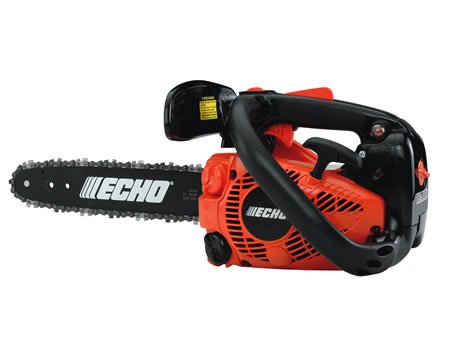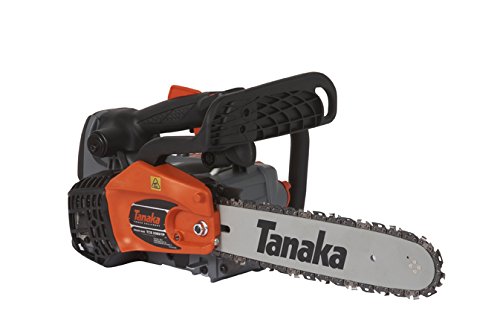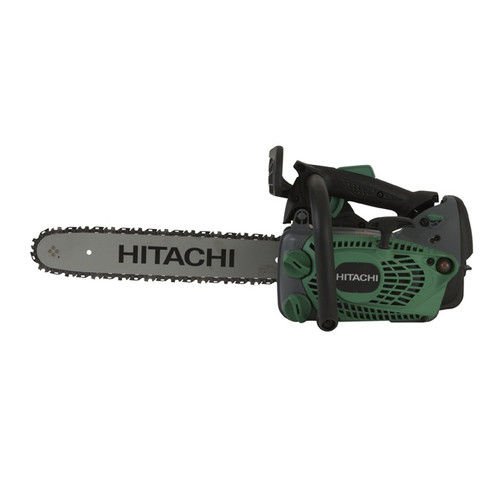As with any tool, there are a variety of chainsaws to fit a variety of tasks. If you’re chopping wood on the ground, then a back-end chainsaw might suit you just fine. If, however, you find yourself off your feet as many an arborist will, then you need something that allows you more substantial control and handling of the weight. Moreover, you might need the ability to use it one-handed, which is simply impossible (or at least reckless beyond belief) with a back-handle chainsaw.
Arborists and others working among trees might be the main users of top-handle chainsaws, but they’re not the only ones. A lot of DIY jobs might be easier if you have more freedom to position a chainsaw how you like and wield it in one hand. If you aren’t an experienced professional then ensure you take in all the safety advice available.
Here, we’re going to look at three of the most popular tools on the market and help you figure out which is the best top handle chainsaw. We’re going to judge them buy efficiency, build-quality, any glaring flaws, value for money, whether it’s best suited for domestic use or has what it takes in a commercial environment, and much more.
1. Echo CS-271T-12 12 Inch Gas Chainsaw – Not the most powerful but light agile and the best top handle chainsaw here

First, let’s look at the Echo CS-271T-12, a gas-fueled, 12-inch chainsaw with a 26.9cc engine. It’s priced around the mid-$300 range on average, making it the most expensive model we’re going to take a look at. The Echo brand is a premium offering but is it worth the extra cost?
The good
If you find the 12-inch bar and chain aren’t for you, you can replace them with a 14” or 16” one instead, though that does require spending a little more. On the other hand, the small size makes it just the right fit for arborists used to working primarily in residential areas, with need for little other than a tool that can help with yard cleanup.
At a measly 11 lbs. in weight, it’s remarkably easy to use even with the gas engine thanks to a sturdy anti-vibration handle. It also has a fine balance, meaning it can perfect for those trickier jobs.
The bad
The gas, 26.9cc engine does make it a little underpowered when combined with larger bars and chains. This means it may not be the best suited for thicker wood chunks, but that might not necessarily be what it’s best used for, either.
The one glaring flaw, regardless of how it’s used, is a handbrake that’s not particularly comfortable or ergonomically placed. Moreover, it feels like a rather flimsy piece of plastic that shows signs of bending when you attempt to disengage the saw.
Summary
Pro’s
- Lightweight and easy to work with, saves a lot of effort lugging it from tree to tree
- Can fit larger bars and chains
- Perfectly suited for arborist work in residential areas
- Well balanced and easy to handle
Con’s
- A little underpowered compared to the other competitors
- Brake can be hard to engage, feels flimsy compared to the rest of the product
- A little underpowered for some, maybe, might not work as well as you want with larger bars or chains
2. Tanaka TCS33EDTP 14 Inch Gas Chainsaw – Good cutting power and fuel economy but on the heavy side

Next up is the Tanaka TCS33EDTP/14, a 14-inch saw (with a 12-inch model also offered), with a 32.2cc PureFire Engine. The PureFire Engine, created by Tanaka themselves, is touted as a truly commercial grade piece of equipment, providing more power for lower emissions. At an average of $240 on the market, is it a worthy competitor to the impressive Echo?
The good
There are two immediate differences noticeable between the Tanaka and the Echo when you first pick it up and get it started. The first difference is the weight, which we’ll cover more. The second, however, is the extra kick that a further 6 ccs give to the saw.
The Tanaka takes on oaks and walnuts with little trouble, and softwood feels like it may as well not be there when you touch the saw to the wood. It doesn’t fall behind the Echo in terms of balance or sturdiness, either. The Pure Fire engine proves to be as impressive as boasted, giving it a good fuel economy that means it’s lighter on the wallet in the long-term, not just immediately.
The bad
An extra 1.4.lb of weight it has on the Echo might not seem like much, but when you’re trying to use it up a tree with one hand, it’s easily felt. It also sees a few problems with longer-term use. In particular, it can start to overheat, the chain can loosen, and worse yet, it’s known to suffer from oil leaks long term.
The summary
Pro’s
- High-powered, suitable for tackling hardier woods
- Fuel-efficient, cost-saving in the long-run
- Well-balanced and feels sturdily built initially
Con’s
- A little heavier than the echo, which makes it less suited for one-handed use
- Long-term use highlights a few build issues, such as loosening chains and leaking oil
- Might not be suited for commercial use
3. Hitachi CS33EDTP 14 Inch Gas Powered Chainsaw – Starts easily and well made but again a little heavy for a one handed chainsaw

Finally, let’s look at the Hitachi CS33EDTP, a 14-inch 32.2cc powered chainsaw. Like the Tanaka, this uses a Pure Fire engine. This one also boasts advanced anti-vibration systems that are supposed to keep it more comfortable for sustained use. Just like the Tanaka, it costs an average of $240.
The good
The Hitachi is almost identical to the Tanaka in its strengths. For the price, you’re getting a very decently powered saw that is perfect for making quick work of pruning hardwoods and softwoods alike.
Like the Tanaka, one-handed use halfway up a tree might not be the best way to use it, but for its price and size, it’s remarkably able at taking trees down instead. One noteworthy difference between both Tanaka and Hitachi when compared to the Echo is that the kick in the engine is much more able to handle larger bars and chains than what comes as standard. If you have a 16-inch blade, you’ll have enough power to use it with little issue
The bad
Just like the Tanaka, the immediate issue with the Hitachi is 12.4lb. weight, making it less friendly to one-handed use over a long period of time. It seems to have all the issues that its Tanaka cousin has, as well, including the fact that it’s prone to leak oil, requiring more refills than it should.
The summary
Pro’s
- High-powered and high-quality with few issues initially
- Started on two-pulls consistently
- Just as good for cutting trees as it is for pruning and yard work
Con’s
- Again, oil leaks are a problem with longer-term use
- Heavier than the Echo, not as suited to one-handed work
And your best top handle chainsaw test winner is…
We’re going to have to give it to the Echo, here. The Tanaka and the Hitachi are, simply put, almost identical. They’re both a little too heavy for one-handed use and they seem to have the same long-term issues.
The Echo might not be the most powerful of the three, but if you want something that you can use one-handed while up in trees, then it’s a safer bet. The Echo is therefore the best arborist chainsaw of the 3 even if it occasionally has a few issues with the handbrake.
At the end of the day, top-handed chainsaws are best used by arborists precisely for the one-handed capabilities they provide. The Hitachi and Tanaka work just fine, but there’s little reason to choose them over a back-handled chainsaw if you’re not able to comfortably use them as intended given the weight issues.

